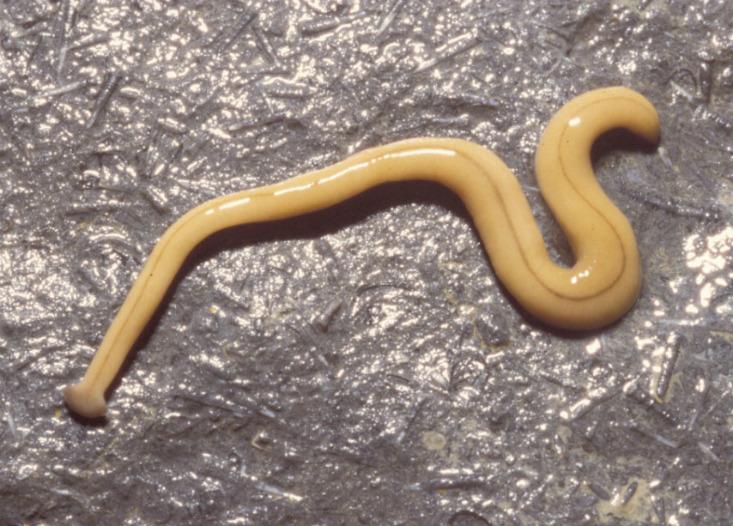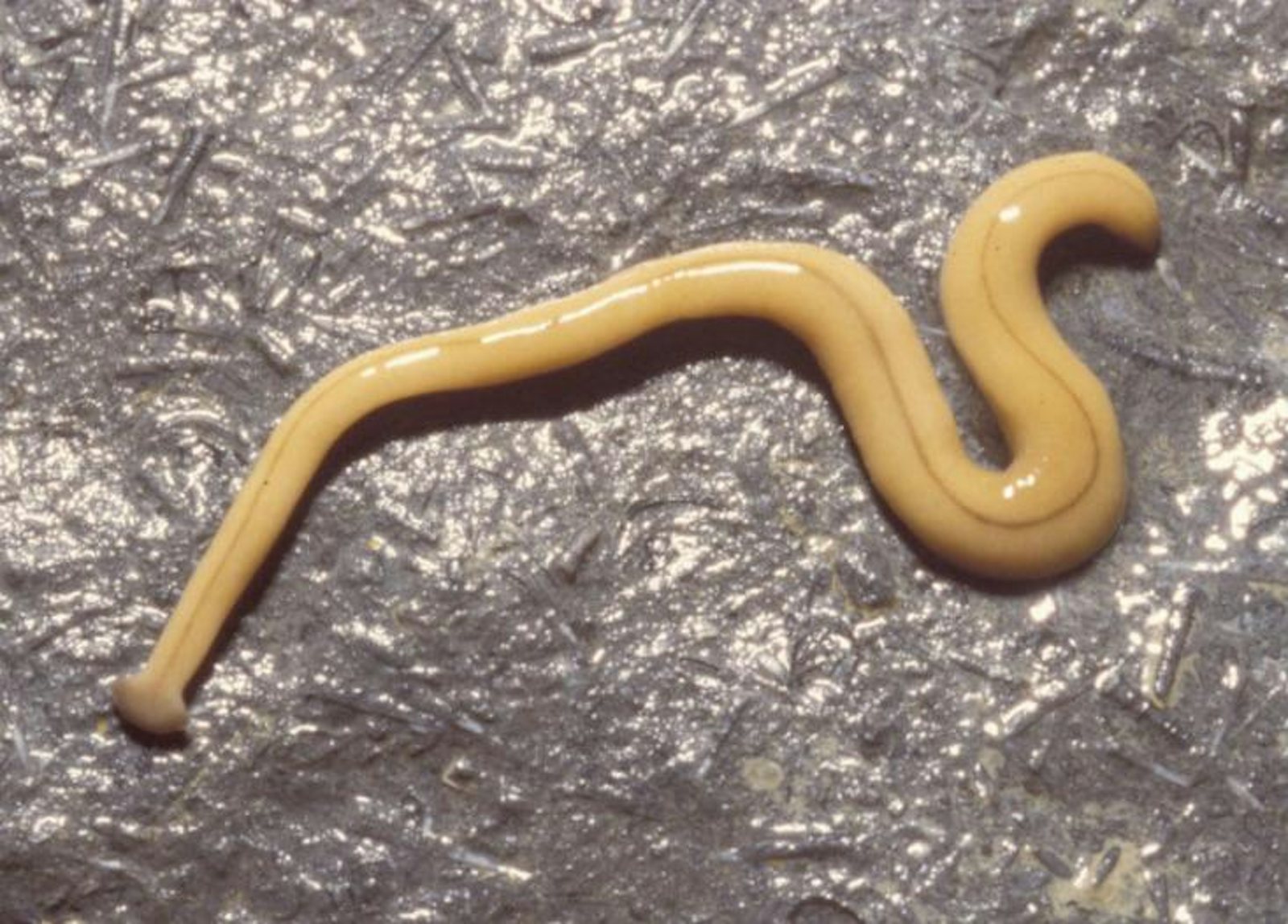
Lurking in the soil, even under a most peaceful and well-nurtured garden, is a surprisingly fierce predator: Bipalium adventitium, an invasive flatworm that began appearing in the United States about 100 years ago, likely hitching a ride in potted plants from Asia. Though harmless to humans, these flatworms can hunt and eat earthworms more than 10 times their own mass. Even when earthworms use their distinctive defense, breaking apart and slithering away, the flatworms track down and devour them.
“Yes, they’re rather violent,” says Peter Ducey, an evolutionary ecologist at SUNY Cortland. “In fact, they will attack an earthworm up to 100 times their size, eat what they can and leave the rest for dead.” Also, there’s this: “When this flatworm eats, its mouth comes out of its body, and lays like a sheet on the prey,” Ducey says. “This sheet releases enzymes that actually liquify the earthworm, so the flatworm can simply drink the remnants.”
If that’s not a worm with a horror-film future, I’m not sure what is. You’re welcome, screenwriters.
It turns out that these worms have another powerful tool in their arsenal, liquefying enzymes aside. In a fascinating discovery published earlier this summer, scientists confirmed the presence of tetrodotoxin, or TTX, in both Bipalium adventitium and a cousin, Bipalium kewanse. Most commonly associated with Japanese pufferfish, TTX works by blocking the voltage-gated sodium channels in nerve and muscle tissue, which prevents the electrical signals that allow muscles to move, resulting in paralysis. The worms seem to use this neurotoxin to immobilize their prey before proceeding to liquify it.
This finding has basically rocked the worlds of the scientists who study the toxin and the animals that harbor it. “TTX is found in a large variety of organisms, from bacteria, to worms and snails, to the pufferfish, but all of these are marine animals,” says Amber Stokes, lead author of the new paper. “Finding a terrestrial invertebrate with TTX is really a novel find, and represents a possible key to a source for TTX. ”
Tetrodotoxin’s origins in fact remain shrouded in mystery and conundrum. Because TTX is a “structurally complex” molecule, it likely requires “several enzymes and many different steps in [its] biosynthesis,” says Becky L. Williams, assistant professor of biology at Utah State University, Uintah Basin. “Such a complicated pathway is unlikely to evolve multiple times in unrelated organisms.” The prevailing theory thus far is that aquatic bacteria produce it, and that it then bioaccumulates up the food web—i.e. TTX-producing bacteria gets eaten by a bigger TTX-resistant organism and that gets eaten by another, bigger organism and so on.
But even that idea has holes in it: Pufferfish, for example, likely acquire it from the environment, because fish raised in labs have been shown to have little to no TTX, Stokes says. Whereas lab-raised, TTX-bearing newts actually become more toxic over time, suggesting they are making it internally somehow, perhaps via symbiotic bacteria in the gut or another unknown mechanism.
The new find “gives us a whole new set of questions to look at,” says Edmund “Butch” Brodie Jr., of Utah State University, who has been studying TTX-ridden newts and the garter snakes that eat them for more than 50 years. “Clearly this toxin [in terrestrial flatworms] is not coming from an aquatic bacterium. In this system the flatworm may produce it or it may be concentrated from something the flatworm eats. There are marine flatworms that also have TTX, so whether that means that flatworms in general can produce it or are merely concentrating it from what they eat, I don’t know.”
“A number of labs around the world are tying to sort this out with their own systems, and it’s virtually impossible to demonstrate that one or the other is not happening,” Brodie adds. “My guess is that it appears in some animals one way, and in others another way.”
Part of the confusion comes from the fact that tetrodotoxin has such a wide range of functions across species. It seems to serve three main purposes: as an offensive venom used to subdue prey, a defense against predators, and, surprisingly, a message in inter- and intra-species communication. For example, the Bipalium flatworms (as well as some marine worms) likely use it solely for hunting, judging by the concentration of TTX in the head, from where the worm uses it to attack. In contrast, TTX is found in the skin of the pufferfish, so it’s likely that they use it to ward off predators. It is also in the eggs of certain horseshoe crabs and marine flatworms, suggesting it serves to protect the eggs from being preyed upon.

And for at least one species of puffer, TTX seems to act as a love potion; sexually receptive males can even find their way through a maze to it, according to one study. On the other hand, some snails have been shown to seek out food that contains TTX, a behavior that may have evolved if accumulating TTX in the diet offers selective advantage, such as a defense from predators. Still other species, namely newts, use TTX as a warning cue. “In some populations, there is a lot of cannibalism. The young newts can detect TTX in the water, which probably means there is an adult nearby and they could be eaten, so they know to hide,” Stokes says.
All of this taken together has lead some scientists to claim TTX as a “keystone” molecule, meaning it produces such powerful behavioral effects on so many organisms that it could play a large role in structuring ecosystems in general. But that too, is up for debate, Williams cautions: No one has been able to definitively prove that TTX is essential for any species’ survival.
Like certain snails, humans also seem to be drawn toward tetrodotoxin. The first recorded incidences of pufferfish intoxication come from ancient China, more than 2,000 years ago. Pufferfish, or “fugu,” is still eaten today as a delicacy in East Asia, but is only safe when prepared by specially trained chefs.
In the early 1900s, a Japanese scientist named Yoshizumi Tahara became the first person to isolate the purified toxin from the ovaries of a puffer, naming it after the pufferfish family Tetraodtontidae. As a poison, TTX is more powerful than cyanide; a lethal dose in humans is two to three milligrams. Scientists eventually found chemical in certain frogs, newts, and salamanders, as well as crabs, gastropods, starfish, certain alga, and the infamous blue-ringed octopus. One bite from this small creature, found in shallow tide pools off the coasts of Australia and Japan, and you can be dead within 20 minutes. “In mammals, death is usually the result of paralysis of the diaphragm,” Stokes explains. “if your diaphragm is paralyzed, you suffocate.”
Tetrodotoxin was also reputed to be the active ingredient in “zombie powder” of Haitian voodoo cultures, though the claim is heavily disputed. Ian Fleming, author of the James Bond books, was fond of TTX as a plot point: In both From Russia With Love and Dr. No it was the chemical behind attempted Bond assassinations. In 2011, a Chicago man admitted to buying the toxin on the Internet in a plot to kill his wife.
More recently, TTX has become interesting to neurologists because of its potential to treat cancer patients with neuropathy, or nerve pain, brought on by certain chemotherapies, explains Samuel Goldlust, lead investigator on an ongoing placebo-controlled trial of TTX. “In tiny doses, thousands and thousands of times smaller than what you see in nature, it can block sodium channels—and therefore block pain signals from getting to the brain—without causing the muscle weakness or paralysis.”
Right now Goldlust and his team are finishing up phase II of the trial to suss out the appropriate dose; if treatment does well, they hope to get FDA approval by 2018. After that, TTX—which is delivered via injection like that other toxin-turned-medicine, Botox—could be used to treat other types of nerve pain.
Although people have studied tetrodotoxin for decades and have found it in far-flung parts of the food web, there is still so much about it we do not know. It could mean everything for the animals that harbor it and the ecosystems it’s found in—or it could be just a chemical curiosity. The surprise discovery of TTX in an invasive, terrestrial flatworm has made the picture even more complicated, for now. But after further research, it could be the key to finally pinning down a source of TTX, and help scientists finally tie together the many threads in this mystery.
Amelia Harnish is a writer in Brooklyn, NY.






























